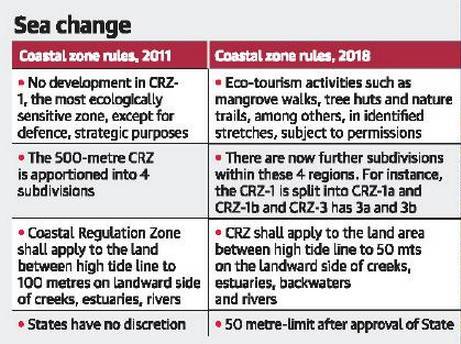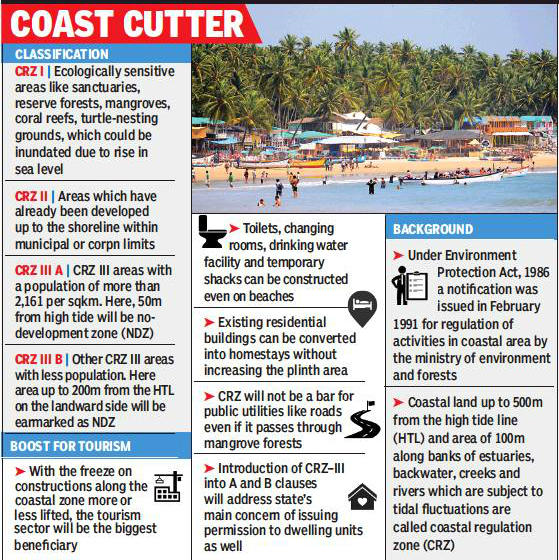Coastal Regulation Zone (CRZ) Rules 17/05/2019 – Posted in: Blog – Tags: Coastal rule 2011, Coastal rule 2019, CRZ
COASTAL REGULATION ZONE RULES
For: Preliminary & Mains
Topic covers: CRZ, News Rules
News Flash
The Supreme Court recently ordered the demolition of five apartments in Ernakulam’s Maradu municipality for violation of Coastal Regulation Zone (CRZ) rules/norms.
Regulation Zone
In all Coastal Regulation Zone Rules, regulation zone has been defined as the area up to 500 m from the high-tide line. Several kinds of restrictions apply, depending on criteria such as population, ecological sensitivity, distance from shore, etc.
Coastal Regulation Zone Rules
- CRZ Rules govern human and industrial activity close to the coastline, in order to protect the fragile ecosystems near the sea.
- The Rules, mandated under the Environment Protection Act, 1986, were first framed in 1991.
What do the rules do?
They sought to restrict certain kinds of activities, like large constructions, setting up of new industries, storage or disposal of hazardous material, mining, or reclamation and bunding, within a certain distance from the coastline.
Why such rules needed?
The basic idea is: because areas immediately next to the sea are extremely delicate, home to many marine and aquatic life forms, both animals and plants, and are also threatened by climate change, they need to be protected against unregulated development.
Evolution of rules
- The Centre notified fresh Coastal Regulation Zone Rules in 2011, which addressed some concerns. An exemption was made for the construction of the Navi Mumbai airport. (The POSCO project had failed to take off due to other reasons.) Projects of the Department of Atomic Energy, which plans to set up nuclear power plants near the coast, were exempted.
- After even these Rules were found inadequate, however, the Environment Ministry in 2014 set up a six-member committee under then Earth Sciences Secretary Shailesh Nayak to give suggestions for a new set of CRZ Rules. The committee submitted its report in 2015.
- Simultaneously, the Chennai-based National Centre for Sustainable Coastal Management defined a new high-tide line along India’s entire coastline to remove ambiguities. Separately, the Survey of India defined a hazard line along the coasts — to be used mainly for disaster management planning.
Based on these and other inputs, the Environment Ministry issued fresh CRZ Rules in December 2018, which removed certain restrictions on building, streamlined the clearance process, and aimed to encourage tourism in coastal areas.
New Rules
- The January this year, the government notified new CRZ Rules.
- The stated objectives of CRZ rules are of promoting sustainable development and conserving coastal environments.
- The new Rules have a no-development zone of 20 m for all islands close to the mainland coast, and for all backwater islands in the mainland.
Salient Features of CRZ rules 2019
- Allowing FSI as per current norms in CRZ areas: As per CRZ, 2011 Notification, for CRZ-II (Urban) areas, Floor Space Index (FSI) or the Floor Area Ratio (FAR) had been frozen as per 1991 Development Control Regulation (DCR) levels. In the CRZ, 2018 Notification, it has been decided to de-freeze the same and permit FSI for construction projects, as prevailing on the date of the new Notification. This will enable redevelopment of these areas to meet the emerging needs.
- Densely populated rural areas to be afforded greater opportunity for development: For CRZ-III (Rural) areas, two separate categories have now been stipulated as below:
(a) CRZ-III A – These are densely populated rural areas with a population density of 2161 per square kilometer as per 2011 Census. Such areas shall have a No Development Zone (NDZ) of 50 meters from the High-tide level (HTL) as against 200 meters from the High Tide Line stipulated in the CRZ Notification, 2011 since such areas have similar characteristics as urban areas.
(b) CRZ-III B – Rural areas with population density of below 2161 per square kilometer as per 2011 Census. Such areas shall continue to have an NDZ of 200 meters from the High-tide level (HTL).
- Tourism infrastructure for basic amenities to be promoted: Temporary tourism facilities such as shacks, toilet blocks, change rooms, drinking water facilities etc. have now been permitted in Beaches. Such temporary tourism facilities are also now permissible in the “No Development Zone” (NDZ) of the CRZ-III areas as per the Notification. However, a minimum distance of 10 m from HTL should be maintained for setting up of such facilities.
- CRZ Clearances streamlined: The procedure for CRZ clearances has been streamlined. Only such projects/activities, which are located in the CRZ-I (Ecologically Sensitive Areas) and CRZ IV (area covered between Low Tide Line and 12 Nautical Miles seaward) shall be dealt with for CRZ clearance by the Ministry of Environment, Forest and Climate Change. The powers for clearances with respect to CRZ-II and III have been delegated at the State level with necessary guidance.
- A No Development Zone (NDZ) of 20 meters has been stipulated for all Islands: For islands close to the main land coast and for all Backwater Islands in the main land, in wake of space limitations and unique geography of such regions, bringing uniformity in treatment of such regions, NDZ of 20 m has been stipulated.
- All Ecologically Sensitive Areas have been accorded special importance: Specific guidelines related to their conservation and management plans have been drawn up as a part of the CRZ Notification.
- Pollution abatement has been accorded special focus: In order to address pollution in Coastal areas treatment facilities have been made permissible activities in CRZ-I B area subject to necessary safeguards.
- Defence and strategic projects have been accorded necessary dispensation.
Source: Indian Express
You can follow us on LinkedIn and for more updates related to UPSC IAS Preparation, Like our Facebook Page and subscribe our Diligent IAS Youtube Channel


